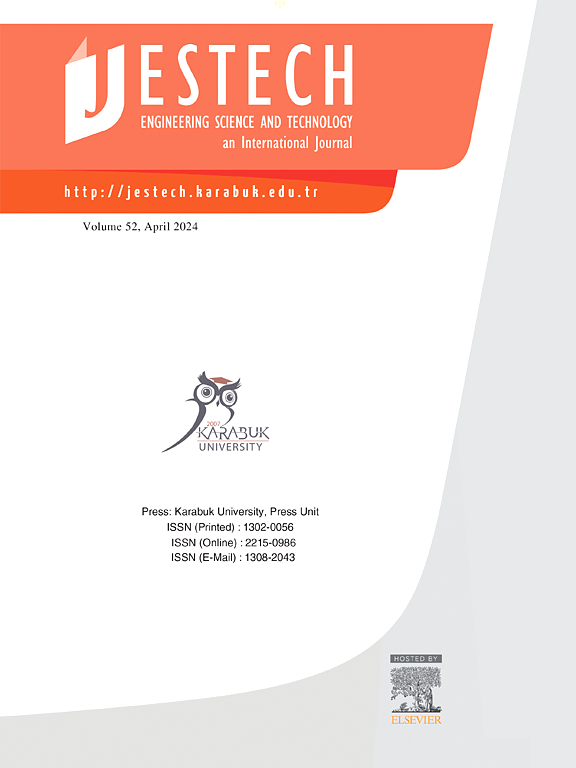Synchronous reluctance machine design considering slotting effect and rotor topology optimization
IF 5.1
2区 工程技术
Q1 ENGINEERING, MULTIDISCIPLINARY
Engineering Science and Technology-An International Journal-Jestech
Pub Date : 2025-07-10
DOI:10.1016/j.jestch.2025.102140
引用次数: 0
Abstract
This research explores design criteria for a synchronous reluctance machine (SynRM) with a four-layer rotor flux barrier structure with different design shapes. The main focus is to investigate slot harmonics and the angle influence of rotor flux barrier ends on the machine’s electromagnetic and structural performance. Firstly, an analytical relationship is derived between the slot harmonics, flux barrier angle, and its impact on the machine’s electromagnetic performance. An optimization analysis is conducted for different rotor flux barrier design shapes, focusing on the impact of angle variation of flux barrier ends on the airgap flux density, torque, torque ripples, radial forces, vibration, and noise behaviour of SynRM designs. A performance improvement method based on flux barrier ends angle optimization for SynRM is proposed through the cancellation of phases between the fundamental wave and slot harmonics. The best and worst design scenarios for SynRM design obtained through angle variation of the flux barrier ends are explored considering its electromagnetic and structure performance metrics. The proposed method and optimization technique are validated for different designs of SynRM with fluid shapes and straight segmented shapes flux barriers under different slot pole combinations. The suggested angle optimization method for flux barrier ends significantly minimizes torque ripple and enhances the electromagnetic and vibro-acoustic behaviour of SynRMs, thus expanding their applicability across various application areas.
考虑开槽效应和转子拓扑优化的同步磁阻电机设计
本研究探讨了具有不同设计形状的四层转子磁阻结构的同步磁阻电机的设计准则。重点研究了槽谐波和转子磁闸端角度对电机电磁性能和结构性能的影响。首先,推导了槽次谐波、磁障角及其对电机电磁性能影响的解析关系;对不同转子磁通屏障设计形状进行了优化分析,重点研究了磁通屏障端角变化对SynRM设计气隙磁通密度、转矩、转矩波纹、径向力、振动和噪声特性的影响。提出了一种基于磁势垒端角优化的SynRM性能改进方法,通过消去基波与槽次谐波之间的相位。结合电磁性能指标和结构性能指标,探讨了通过磁闸端角度变化得到的SynRM设计的最佳和最差设计方案。针对不同槽极组合下具有流体形状和直线分段形状的电磁屏障设计,对所提出的方法和优化技术进行了验证。所提出的磁通屏障端角优化方法可显著降低转矩脉动,提高synrm的电磁和振声性能,从而扩大其在各个应用领域的适用性。
本文章由计算机程序翻译,如有差异,请以英文原文为准。
求助全文
约1分钟内获得全文
求助全文
来源期刊

Engineering Science and Technology-An International Journal-Jestech
Materials Science-Electronic, Optical and Magnetic Materials
CiteScore
11.20
自引率
3.50%
发文量
153
审稿时长
22 days
期刊介绍:
Engineering Science and Technology, an International Journal (JESTECH) (formerly Technology), a peer-reviewed quarterly engineering journal, publishes both theoretical and experimental high quality papers of permanent interest, not previously published in journals, in the field of engineering and applied science which aims to promote the theory and practice of technology and engineering. In addition to peer-reviewed original research papers, the Editorial Board welcomes original research reports, state-of-the-art reviews and communications in the broadly defined field of engineering science and technology.
The scope of JESTECH includes a wide spectrum of subjects including:
-Electrical/Electronics and Computer Engineering (Biomedical Engineering and Instrumentation; Coding, Cryptography, and Information Protection; Communications, Networks, Mobile Computing and Distributed Systems; Compilers and Operating Systems; Computer Architecture, Parallel Processing, and Dependability; Computer Vision and Robotics; Control Theory; Electromagnetic Waves, Microwave Techniques and Antennas; Embedded Systems; Integrated Circuits, VLSI Design, Testing, and CAD; Microelectromechanical Systems; Microelectronics, and Electronic Devices and Circuits; Power, Energy and Energy Conversion Systems; Signal, Image, and Speech Processing)
-Mechanical and Civil Engineering (Automotive Technologies; Biomechanics; Construction Materials; Design and Manufacturing; Dynamics and Control; Energy Generation, Utilization, Conversion, and Storage; Fluid Mechanics and Hydraulics; Heat and Mass Transfer; Micro-Nano Sciences; Renewable and Sustainable Energy Technologies; Robotics and Mechatronics; Solid Mechanics and Structure; Thermal Sciences)
-Metallurgical and Materials Engineering (Advanced Materials Science; Biomaterials; Ceramic and Inorgnanic Materials; Electronic-Magnetic Materials; Energy and Environment; Materials Characterizastion; Metallurgy; Polymers and Nanocomposites)
 求助内容:
求助内容: 应助结果提醒方式:
应助结果提醒方式:


